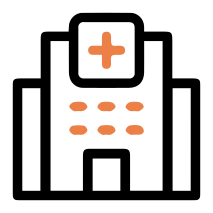What is Robotic Surgery?
Robotic surgery is an advanced surgical technique which is used to perform minimally invasive surgeries by using a cutting edge technology with the precision of a robot.
Robotic surgery involves the use of a robotic system controlled by a skilled surgeon to perform intricate surgical procedures with enhanced precision and dexterity.
How Does the Robotic system works?
The system consists of robotic arms equipped with surgical instruments and a high-definition camera that provides a magnified, 3D view of the surgical site. The surgeon makes tiny holes in the body from which the instruments are inserted into the body to operate on the desired organ.
The surgeon operates the robotic arms from a console, manipulating the instruments with precision-guided movements. He is always in control of the movement of robotic arms through the console by help of a software designed to replicate surgeon’s movements into the robotic arm movement.
The daVinci system is the state of the arm Robotic surgical system and is the first in the world to be used for performing surgeries.
What is Minimally invasive surgery?
Minimally invasive surgery is the name given to a technique of surgery in which very small incisions are given on body part through which instruments are inserted into the cavity to operate on the desired organ. This is in contrast with the conventional Open surgery in which a large cut was made to gain access on the diseased organ.
Advantages of Minimally invasive surgery include reduced trauma to surrounding tissues, lower the risk of infections, and faster recovery times for patients.
What are the benefits of Robotic Surgery?
Robotic surgery offers a number of advantages which is combination of both the laparoscopic and open approach and few advantages unique to its own such as improved precision and ergonomics. Below mentioned are advantages of Robotic surgery both for cancer and benign diseases.
Minimally Invasive Approach: Robotic surgery offers a minimally invasive approach compared to traditional open surgeries. Small incisions are made, reducing trauma to surrounding tissues, lowering the risk of infections, and promoting faster recovery times for cancer patients.
Enhanced Precision and Dexterity: The robotic system provides surgeons with enhanced precision, dexterity, and maneuverability, especially in confined spaces or complex anatomical areas. This allows for precise tumor removal while sparing healthy tissues and vital structures.
Improved Visualization: The 3D, high-definition camera provides a detailed view of the surgical field, enhancing visualization of critical structures and enabling meticulous surgical techniques, even in challenging anatomical locations.
Reduced Blood Loss and Complications: The precise movements of robotic instruments and advanced hemostatic capabilities contribute to reduced blood loss during surgeries. This translates to lower risks of transfusions, postoperative complications, and shorter hospital stays for cancer patients.
Faster Recovery and Quicker Return to Normal Activities: Patients undergoing robotic cancer surgery often experience faster recovery times, reduced postoperative pain, and a quicker return to their daily routines and work activities, promoting overall quality of life.
Applications of Robotic Surgery
Robotic surgery has revolotionized the field of minimally invasive surgery. It is used for both benign and malignancy cases on almost all of the organs and its applications are extending with advancement in technology.
Various examples of uses of robotic surgery include
Urological procedures: Robotic-assisted Radical Prostatectomy, Partial and Radical Nephrectomy, Cystectomy: , Pyeloplasty, Adrenalectomy, Ureteral Reimplantation, Radical Cystectomy with Urinary Diversion, Retroperitoneal Lymph Node Dissection (RPLND)
Gynecological conditions: Radical hysterectomy, simple hysterectomy, Pelvic lymph node dissection, Radical trachelectomy, Myomectomy, Endometriosis excision, and Sacrocolpopexy.
Gastrointestinal Procedures: Robot assisted colorectal cancer resection with partial or total colectomy, Anterior resection and low anterior resection, Gastrectomy, pancreatic cancer resection, whipple’s procedure, Cholecystectomy, appendectomy, liver resection for benign and malignant lesions, Esophageal disorders, Hernial repair, Fundoplication for GERD.
Thoracic Procedures: Robotic lung resection for benign and cancerous lesions including lobectomy, segmentectomy, pneumonectomy, Robotic mediastinal tumor excision and Mediastinal lymph node dissection, decortication, Esophagectomy, Tracheal resection etc.
Cardiac procedures such as CABG, Mitral valve repair, tumor excision etc can be done with precision with the help of robot assisted surgery.
Risks of Robotic surgery (Is Robotic surgery safe?)
Although Robotic surgery is fairly a safe procedure but like any medical procedure it has its associated risks.
various risks and other considerations associated with robot assisted surgery include:
Equipment Failure: While rare, technical issues or equipment malfunctions during surgery can occur, requiring quick intervention and potentially switching to traditional surgical methods.
Limited Haptic Feedback: Robotic systems provide visual and auditory feedback to surgeons but lack direct tactile sensation (haptic feedback), which may require surgeons to rely more on visual cues and experience.
Learning Curve: Surgeons and operating room staff require specialized training to operate robotic systems effectively, and there may be a learning curve associated with adopting this technology.
Procedure Suitability: Not all surgical procedures are suitable for robotic assistance, and the decision to use robotic surgery depends on factors such as patient anatomy, surgical complexity, and surgeon expertise.
Cost of Robotic Surgery
Robot assisted surgery is more expensive than the traditional open surgery due to equipment charges, training requirements, and maintenance expenses.
Cost in INR ranges from minimum about 2oo,ooo Rupees to 1,000,000 or more depending on the procedure, consumables, stay in the hospital and other expenses.
Disadvantages of Robotic surgery
Robotic surgery offers a numerous advantages as mentioned above, it has a few disadvantages and they include cost of the procedure which is higher than open surgery, increased learning curve for the surgeon to master a procedure, Increased surgical time atleast in initial part of learning, dependency on the equipment, Maintenance of the equipment, and accessibility to the Robot which may not available at each centre.











 and then
and then